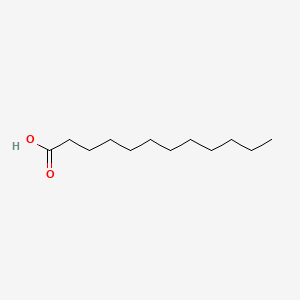lauric acid
lauric acid is a lipid of Fatty Acyls (FA) class. Lauric acid is associated with abnormalities such as Infection, Renal tubular disorder, Hypertensive disease, Obesity and Mycoses. The involved functions are known as Transcription, Genetic, Signal Transduction, Mutation, metaplastic cell transformation and Anabolism. Lauric acid often locates in Skin, Plasma membrane, Cytoplasmic matrix, Body tissue and Palmar surface. The associated genes with lauric acid are Gene Family, SLC33A1 gene, Homologous Gene, Open Reading Frames and P4HTM gene. The related lipids are Fatty Acids, Oleic Acids, Palmitates, Stearates and 9,11-linoleic acid.
Cross Reference
Introduction
To understand associated biological information of lauric acid, we collected biological information of abnormalities, associated pathways, cellular/molecular locations, biological functions, related genes/proteins, lipids and common seen animal/experimental models with organized paragraphs from literatures.
What diseases are associated with lauric acid?
lauric acid is suspected in Renal tubular disorder, Hypertensive disease, Infection, Renal vascular disorder, Obesity, Mycoses and other diseases in descending order of the highest number of associated sentences.
Related references are mostly published in these journals:
| Disease | Cross reference | Weighted score | Related literature |
|---|
Possible diseases from mapped MeSH terms on references
We collected disease MeSH terms mapped to the references associated with lauric acid
PubChem Associated disorders and diseases
What pathways are associated with lauric acid
There are no associated biomedical information in the current reference collection.
PubChem Biomolecular Interactions and Pathways
Link to PubChem Biomolecular Interactions and PathwaysWhat cellular locations are associated with lauric acid?
Visualization in cellular structure
Associated locations are in red color. Not associated locations are in black.
Related references are published most in these journals:
| Location | Cross reference | Weighted score | Related literatures |
|---|
What functions are associated with lauric acid?
Related references are published most in these journals:
| Function | Cross reference | Weighted score | Related literatures |
|---|
What lipids are associated with lauric acid?
Related references are published most in these journals:
| Lipid concept | Cross reference | Weighted score | Related literatures |
|---|
What genes are associated with lauric acid?
Related references are published most in these journals:
| Gene | Cross reference | Weighted score | Related literatures |
|---|
What common seen animal models are associated with lauric acid?
There are no associated biomedical information in the current reference collection.
NCBI Entrez Crosslinks
All references with lauric acid
Download all related citations| Authors | Title | Published | Journal | PubMed Link |
|---|---|---|---|---|
| Wilks J and Golovkina T | Influence of microbiota on viral infections. | 2012 | PLoS Pathog. | pmid:22615558 |
| Nguyen MT et al. | Regulation of chemokine and chemokine receptor expression by PPARγ in adipocytes and macrophages. | 2012 | PLoS ONE | pmid:22529965 |
| Guo J et al. | Characterization of a novel esterase Rv0045c from Mycobacterium tuberculosis. | 2010 | PLoS ONE | pmid:20957207 |
| Pérez D et al. | A novel halophilic lipase, LipBL, showing high efficiency in the production of eicosapentaenoic acid (EPA). | 2011 | PLoS ONE | pmid:21853111 |
| Zeiger K et al. | Lauric acid as feed additive - An approach to reducing Campylobacter spp. in broiler meat. | 2017 | PLoS ONE | pmid:28419122 |
| Ruiz M et al. | A cardiac-specific robotized cellular assay identified families of human ligands as inducers of PGC-1α expression and mitochondrial biogenesis. | 2012 | PLoS ONE | pmid:23056435 |
| Huang QD et al. | Cyclen-based cationic lipids for highly efficient gene delivery towards tumor cells. | 2011 | PLoS ONE | pmid:21887233 |
| Trupp M et al. | Metabolomics reveals amino acids contribute to variation in response to simvastatin treatment. | 2012 | PLoS ONE | pmid:22808006 |
| Schlievert PM and Peterson ML | Glycerol monolaurate antibacterial activity in broth and biofilm cultures. | 2012 | PLoS ONE | pmid:22808139 |
| Ma X et al. | Acylation of Antioxidant of Bamboo Leaves with Fatty Acids by Lipase and the Acylated Derivatives' Efficiency in the Inhibition of Acrylamide Formation in Fried Potato Crisps. | 2015 | PLoS ONE | pmid:26098744 |
| Gosby AK et al. | Testing protein leverage in lean humans: a randomised controlled experimental study. | 2011 | PLoS ONE | pmid:22022472 |
| Spierings E et al. | A uniform genomic minor histocompatibility antigen typing methodology and database designed to facilitate clinical applications. | 2006 | PLoS ONE | pmid:17183671 |
| Bai X et al. | Nitric oxide enhances desiccation tolerance of recalcitrant Antiaris toxicaria seeds via protein S-nitrosylation and carbonylation. | 2011 | PLoS ONE | pmid:21674063 |
| Lin YC et al. | Glycerol monolaurate and dodecylglycerol effects on Staphylococcus aureus and toxic shock syndrome toxin-1 in vitro and in vivo. | 2009 | PLoS ONE | pmid:19838303 |
| Santosuosso M et al. | R5-SHIV induces multiple defects in T cell function during early infection of rhesus macaques including accumulation of T reg cells in lymph nodes. | 2011 | PLoS ONE | pmid:21483689 |
| Spring S et al. | The photosynthetic apparatus and its regulation in the aerobic gammaproteobacterium Congregibacter litoralis gen. nov., sp. nov. | 2009 | PLoS ONE | pmid:19287491 |
| Bazazi S et al. | The social context of cannibalism in migratory bands of the Mormon cricket. | 2010 | PLoS ONE | pmid:21179402 |
| Taha R et al. | Oxidative stress and mitochondrial functions in the intestinal Caco-2/15 cell line. | 2010 | PLoS ONE | pmid:20676402 |
| Roe B et al. | Metabolomic profile of hepatitis C virus-infected hepatocytes. | 2011 | PLoS ONE | pmid:21853158 |
| Brouwer IA et al. | Effect of animal and industrial trans fatty acids on HDL and LDL cholesterol levels in humans--a quantitative review. | 2010 | PLoS ONE | pmid:20209147 |
